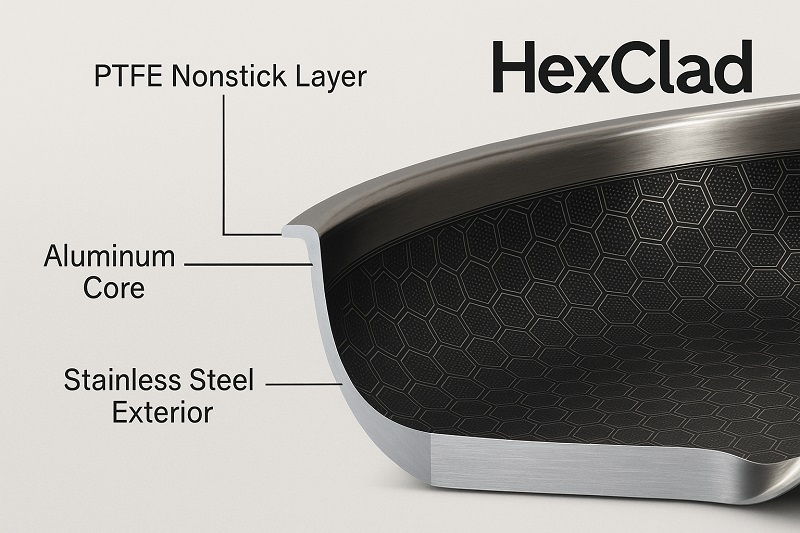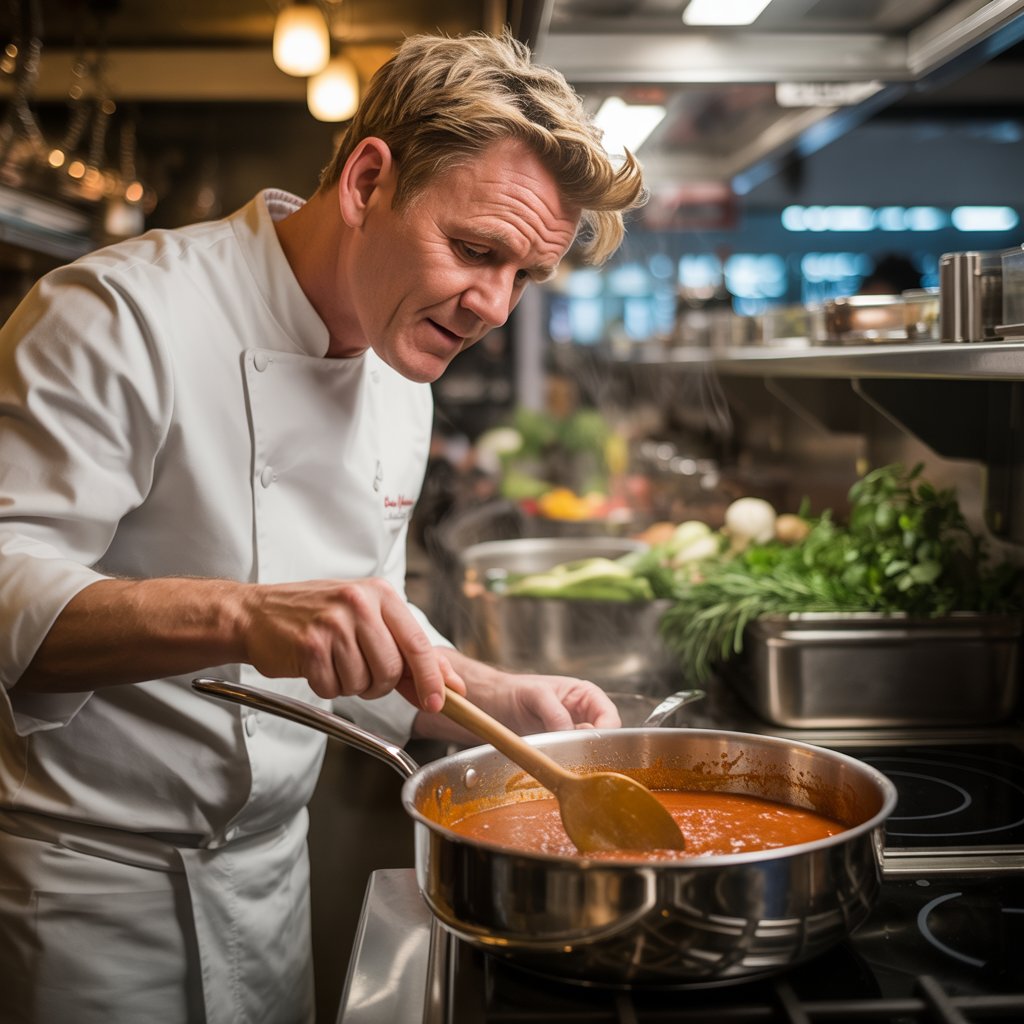✅ Fast Reply: Is HexClad Non Poisonous?
Sure, HexClad is taken into account non-toxic underneath commonplace cooking circumstances. It makes use of a PFOA-free PTFE nonstick coating embedded between layers of chrome steel and aluminum, providing improved security over conventional Teflon pans. Nonetheless, it’s not PTFE-freethat means it have to be used beneath 500°F to keep away from releasing dangerous fumes. For many dwelling kitchens, HexClad is protected when used accurately—however it might not fulfill these looking for 100% pure or chemical-free cookware.
Why Cookware Security Issues
Each health-conscious cook dinner is aware of the significance of fresh substances—however what about clear cookware? With rising concern over poisonous supplies in nonstick pans, the query isn’t simply what we cook dinner, however what we cook dinner on.
Enter HexClad—a cookware model claiming to supply the perfect of each worlds: chrome steel sturdiness with nonstick comfort. Backed by movie star cooks and modern advertising and marketing, it seems to be like the proper resolution. However is it actually as non-toxic as marketed? Or is that this hybrid cookware simply one other hyped-up development?
Let’s dive into the science behind HexClad’s supplies, security claims, and the way it stacks up in a health-focused kitchen.
What Is HexClad?
HexClad is named “hybrid cookware” as a result of it combines:
- A chrome steel exterior and inside
- An aluminum core for even warmth distribution
- A laser-etched PTFE nonstick coating, embedded between layers of metal
This design goals to offer a scratch-resistant, dishwasher-safe, metal-utensil-friendly pan that performs throughout the board. Outstanding endorsements (like Gordon Ramsay) and modern design have made HexClad a viral favourite—however it’s the non-toxic declare that actually captures health-savvy customers.
What Is HexClad Made Of?
- Stainless Metal (18/10):
This types the cooking floor and outer layer. Chrome steel is usually considered protected, sturdy, and non-reactive. Nonetheless, hint quantities of nickel or chromium could leach if cooking acidic meals over lengthy durations.
- Aluminum Core:
Used for its warmth conductivity, aluminum is sandwiched between the metal layers to distribute warmth evenly. It’s not in direct contact with meals, lowering publicity threat.
- PTFE Nonstick Coating:
PTFE (Polytetrafluoroethylene), generally often known as Teflon, is utilized in HexClad’s nonstick layer. HexClad claims it’s PFOA-free—a serious enchancment—however PTFE nonetheless requires cautious temperature management to keep away from degradation.
- Laser-Etched Hex Sample:
This patented hexagonal design leaves chrome steel uncovered over the nonstick floor, defending it from scratches and doubtlessly lowering PTFE put on.
Key Be aware: PTFE is taken into account protected beneath 500°F. Issues happen if it’s overheated, releasing fumes which can be dangerous to birds and doubtlessly irritating to people.
Does HexClad Have Teflon?
Sure, HexClad cookware incorporates Teflon, or extra precisely, PTFE (Polytetrafluoroethylene)—the chemical compound initially branded as Teflon. Whereas HexClad is PFOA-free, it nonetheless makes use of a PTFE-based nonstick coating embedded beneath a laser-etched chrome steel floor.
This hybrid design provides improved sturdiness and scratch resistance in comparison with conventional nonstick pans, however it nonetheless requires temperature management to stop PTFE degradation. For customers on the lookout for fully PTFE-free cookware, choices like ceramic or forged iron are higher alternate options.
✅ Key Level: HexClad makes use of PTFE (Teflon) in a contemporary, bolstered kind—so whereas it’s safer than previous Teflon pans, it’s not 100% Teflon-free.
Is HexClad Protected?
Sure, HexClad is usually protected for on a regular basis cooking—if used underneath 500°F and dealt with correctly.
It makes use of PFOA-free PTFE, which is secure at regular cooking temperatures (350–450°F). Nonetheless, if the pan is overheated—particularly when empty—it might launch fumes which can be dangerous to birds and presumably irritating to people. Moreover, PTFE isn’t biodegradable, which raises long-term environmental issues.
Let’s break down the important thing security issues:
✅ PTFE Security Profile (as utilized in HexClad):
- Secure underneath 500°F
- Degrades at 570°F+, releasing fumes
- Not inherently poisonous at typical cooking temps (350–450°F)
❌ Issues:
- Unintentional overheating (e.g., preheating an empty pan) can exceed 500°F inside minutes
- PTFE isn’t biodegradable and raises issues about environmental persistence
✅ PFOA-Free Issues:
HexClad’s PTFE is manufactured with out PFOA, a carcinogenic chemical phased out by the EPA in 2015. It is a vital step ahead however not a whole assure of toxin-free efficiency.
Temperature Breakdown Chart
| Materials | Protected Use Temp | Toxicity Threat |
| PTFE (HexClad) | As much as 500°F | Excessive at 570°F+ |
| Ceramic | As much as 600°F | Low |
| Solid Iron | 700°F+ | Very Low |
| Stainless Metal | 600°F+ | Very Low |
HexClad Non Poisonous In comparison with Teflon and Ceramic
HexClad vs. Teflon (Conventional Nonstick Pans)
| Characteristic | HexClad | Conventional Teflon |
| PTFE-based | ✅ Sure | ✅ Sure |
| PFOA-free | ✅ Sure | ❌ Older variations used PFOA |
| Warmth tolerance | As much as 500°F | Typically underneath 400°F |
| Scratch resistance | ✅ Excessive | ❌ Low |
| Fume threat if overheated | Low | Excessive |
| Longevity | Medium–Excessive | Low |
| Security notion | Average | Low |
HexClad vs. Ceramic Cookware
| Characteristic | HexClad | Ceramic Cookware |
| PTFE-Free | ❌ | ✅ |
| Coating Kind | Artificial PTFE | Silica-based (inorganic) |
| Nonstick Efficiency | Excessive | Average (declines over time) |
| Leaching Threat | Low | Very Low |
| Oven Security | As much as 500°F | Typically as much as 600°F |
| Eco-Friendliness | Average | Excessive |
| Lifespan | Medium–Excessive | Low–Medium |
Ultimate Thought: HexClad finds a candy spot: extra sturdy and safer than conventional Teflon, however not as “clear” or chemical-free as ceramic.
HexClad vs. Different Non-Poisonous Cookware Choices
| Characteristic | HexClad | Ceramic | Solid Iron | Stainless Metal | Teflon (Outdated) |
| PTFE-Free | ❌ | ✅ | ✅ | ✅ | ❌ |
| Oven Protected Temp | 500°F | 450–600°F | 500°F+ | 600°F+ | 400°F |
| Dishwasher Protected | ✅ | ✅ | ❌ | ✅ | ✅ |
| Steel Utensil Protected | ✅ | ❌ | ✅ | ✅ | ❌ |
| Longevity | Medium–Excessive | Medium | Excessive | Excessive | Low |
Verdict: HexClad performs nicely, however it’s not as “clear” as PTFE-free ceramic or forged iron.
Frequent Misconceptions About HexClad Security
- Fantasy 1: “PTFE is unsafe at any temperature.” — False. PTFE is secure underneath regular cooking warmth.
- Fantasy 2: “PFOA-free means toxin-free.” — False. PTFE remains to be artificial.
- Fantasy 3: “Chrome steel is totally inert.” — False. Nickel or chromium can leach with acidic meals.
Testing and Certifications
- No public third-party lab outcomes can be found on HexClad’s website.
- The model claims FDA compliance and makes use of PFOA-free labeling.
- Certifications to search for:
- NSF Licensed (if current)
- PFOA-Free Labeling
Be aware: Transparency could possibly be improved by releasing unbiased testing studies.
Professional Opinions:
- Kelly Krisna Johnson -Arbor, MDa medical toxicologist, explains that overheated PTFE (above ~500 °F) can launch poisonous fumes inflicting “Teflon flu” with fever, chills, nausea, and fatigue.
- Julie WeberDirector of the Missouri Poison Middle, notes PTFE fumes are “uncommon” however tied to misuse or overheating and emphasizes following cooking directions.
️ How you can Safely Use HexClad Cookware
- Preserve Warmth Average: By no means preheat an empty HexClad pan on excessive warmth.
- Use the Proper Oils: Skip aerosol sprays; use avocado or grapeseed oil.
- Keep away from Abrasives: Steel utensils are okay, however harsh scrubbers cut back lifespan.
- Choose Hand Washing: Although dishwasher-safe, hand washing preserves the coating.
- Stop Warping: Don’t shock a scorching pan with chilly water.
⬇️ For the tip: Use an infrared thermometer to observe floor warmth.
Associated Questions: What Else Do Individuals Ask?
- Is HexClad PTFE-free? No. It makes use of PFOA-free PTFE.
- Can I take advantage of HexClad within the oven? Sure, as much as 500°F.
- Does HexClad leach metals? Chrome steel could leach nickel/chromium with acidic meals.
- Is HexClad eco-friendly? Extra so than previous nonstick pans, however lower than forged iron or ceramic.
Ultimate Verdict: Non-Poisonous or Simply Hype?
HexClad isn’t “poisonous”—however it’s not 100% pure or chemical-free both. Its PFOA-free PTFE floor is safer than previous Teflon pans, and when used accurately, it poses little well being threat. That mentioned, it’s nonetheless an artificial materials with environmental and overheating issues.
So, is it non-toxic or advertising and marketing hype?
It’s someplace within the center. Protected for the common cook dinner, however not the purest possibility for ultra-clean residing.
FAQs
Q1. Is HexClad cookware protected for prime warmth cooking?
Solely as much as 500°F. Overheating PTFE can launch dangerous fumes.
Q2. Does HexClad include Teflon or PTFE?
Sure, it makes use of PFOA-free PTFE.
Q3. What occurs if HexClad is overheated?
PTFE can degrade and launch fumes, dangerous to birds and aggravating to people.
This autumn. Is HexClad higher than ceramic or forged iron for well being?
Ceramic and forged iron are safer when it comes to chemical publicity, however HexClad is extra handy.
Q5. Can HexClad launch poisonous fumes?
Sure, however solely when overheated past 500°F.



